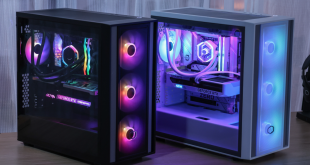The interior of the Arc Midi R2 is instantly recognizable as a Fractal design, thanks in part to the black and white fans, array of gloss white hard drive caddies and gloss white expansion slot covers. Aside from these two areas, the entire of the interior of the case is finished in black.
There are eight hard drive bays in total on the right hand side of the case, all of which can be removed to make room for a radiator in the front of the case if required. They feaure a 5 + 3 configuration so you can just remove the five if you want to boost airflow a little and don't require the extra drives.
Each bay features a caddy which has mounting points for both 2.5″ and 3.5″ drives.
There are an array of cable routing holes cut into the motherboard tray, in addition to a decent amount of room behind the motherboard tray to actually route the cables. This makes it easy to build a tidy system in the Arc Midi 2. There are also a couple of 2.5″ drive mounts, meaning you have somewhere to put your solid state drives if you choose to remove the hard drive bays in favour of a radiator.
Installing a motherboard into the case is a bit of a pain as we are first required to screw in all of the motherboard stand-offs. Fractal Design do supply a small tool to assist with this, though. There is a large cut-out area in the motherboard tray to facilitate CPU cooler backplate installation, however our Socket 2011 motherboard did not require this.
Hooking up the power supply isn't difficult at all as there are a plethora of cut-outs for cable routing and there is plenty of room for long power supplies in the case.
We chose to install our Intel 330 Series SSD into the regular hard drive bays, which require four screws to hold it in place.
Finally, we installed the graphics card into the system which we secured in place using the thumbscrews provided. The screw threads weren't cut especially well into the case so they were quite difficult to screw into place without a screwdriver.
 KitGuru KitGuru.net – Tech News | Hardware News | Hardware Reviews | IOS | Mobile | Gaming | Graphics Cards
KitGuru KitGuru.net – Tech News | Hardware News | Hardware Reviews | IOS | Mobile | Gaming | Graphics Cards








